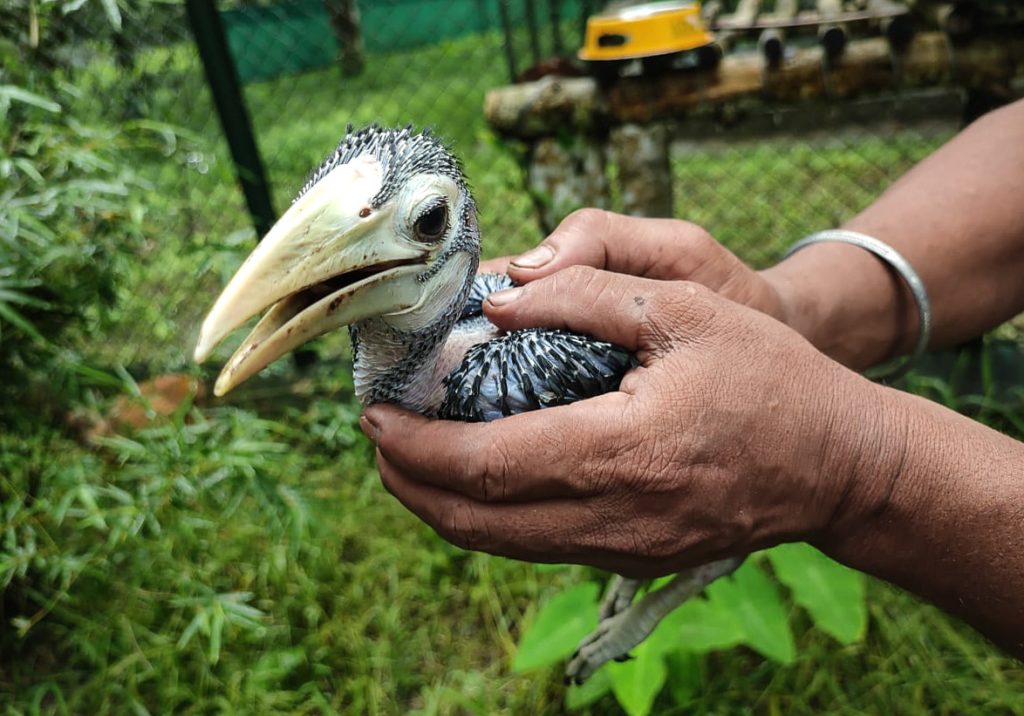Saving a family of hornbills
They can be heard long before they are in sight. The flight of hornbills is one of the most spectacular sights in the wild. Nesting inside hollows of old-growth trees (preferably the big broad ficus), this forest-dwelling bird is a sight to behold as it flies in contrast above green canopies. Sporting a peculiarly large yellowish bill, a white neck and long black feathers, adult hornbills measure close to 5 feet in wingspan!
Among other specialties of the species, hornbills are also known to mate for life. Each of the parents takes up a crucial role in raising their chicks. While the female will seal herself up with the newborns, in their tree cavity, the male will have the responsibility to bring the family nourishment, through a slit that is left open for the exchange. However, there is a twist to the tale and like every other discovery, this too required a sacrifice.

Oriental Pied Hornbill chick at CWRC | Photo by Dr. Samshul Ali
A father gone too soon
Like every other day, Rabindro Deka was headed to the local reservoir. He had been following one particular route so that he could spend a few minutes observing a pair of oriental pied hornbills that has just given birth. These beautiful birds, with their unique beaks, are a treat to watch, especially when they are sharing the responsibilities of parenting. But this was the day when things would go upside down.
Rabindro had waited longer than usual under the huge Albezia tree that hosted the nest in a quiet corner of a tea estate. There was no sign of the male. This wasn’t usual as it had become a habit of him to watch the big birds exchange fruits through the small hole. Concerned and confused, he went ahead to complete his daily routine at the reservoir, and disaster revealed itself. The male hornbill lay lifeless in the waters.
Rabindro was taken aback. This was a family he had involuntarily formed a bond with over the past few weeks. He knew that the chicks and the mother would go hungry and eventually die without the father bringing the food. He had to do something. Gathering a few of his friends from the village, Rabindro managed to bring out the three chicks along with their mother out of their sealed tree hole. The birds were immediately rushed to the Centre for Wildlife Rehabilitation and Conservation (CWRC), a facility that specializes the rescue and rehabilitation of wildlife.
Not orphans yet
If it would have been in the wild, the remaining family too would have perished inside their nest. At CWRC, Dr. Samshul Ali strategized an in-situ enrichment and rehabilitation of the birds. The chicks were put into an artificial nest along with the mother and arrangements were made to continue enrichment. An artificial hornbill beak was used for remote feeding and deliver food into the nest that resembled a similar natural setting that the chicks were born in. But, all would have been in vain, if the mother wouldn’t have accepted the help that was coming in. It took a month of rigorous work and careful strategizing, before the chicks came out of the nest as fledglings, strong enough to use their little wings.

Rescued Oriental Pied Hornbill under observation at CWRC | Photo by Dr. Samshul Ali
Soon enough, they learnt to gather wind under their feathers and started flying with their mother inside the enclosure. It was time to release them back to the wild. “It had been a heartwarming see the chicks take their first flight after almost a month of apprehension”, says Dr. Samshul.
But, more surprises lay ahead.
Steps in the stepfather!
The hornbills had been released close to the ficus they once called home. Rabindro ensured that he was present every day for the daily monitoring of the birds. A week in their new home, in comes another hornbill, a male. A second courtship, a second partner and a second chance at life. It was nothing short of a miracle to see the adult pair make a bond and share the responsibility of the family. Technically termed as alloparenting, this was the first time that such an event has been reported in the history of the species.
Well, as they say, “when you want something really hard, the world will come together to make it happen.” For this family of hornbills, miracle happened in the form of Raju Khutum, Lakhi Ram Das, Tarun Gogoi, Hemakanta Nath – animal keepers at CWRC and Dr. Samshul, who put in their heart into reuniting a family in despair.
Madhumay Mallik is a member of our Communications team, raring to travel and tell conservation stories from the field.









